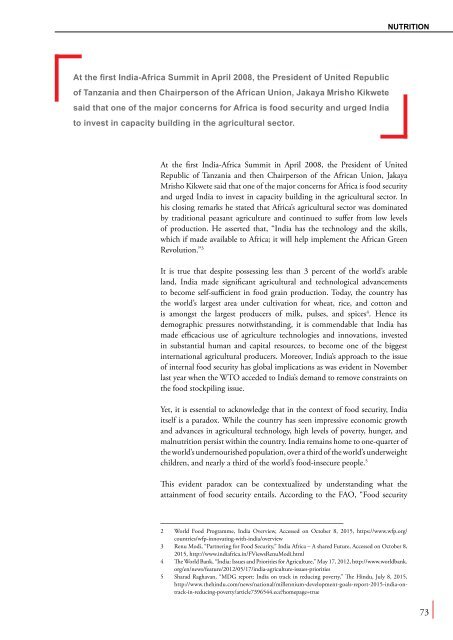Common Futures
II3UUw
II3UUw
Create successful ePaper yourself
Turn your PDF publications into a flip-book with our unique Google optimized e-Paper software.
NUTRITION<br />
At the first India-Africa Summit in April 2008, the President of United Republic<br />
of Tanzania and then Chairperson of the African Union, Jakaya Mrisho Kikwete<br />
said that one of the major concerns for Africa is food security and urged India<br />
to invest in capacity building in the agricultural sector.<br />
At the first India-Africa Summit in April 2008, the President of United<br />
Republic of Tanzania and then Chairperson of the African Union, Jakaya<br />
Mrisho Kikwete said that one of the major concerns for Africa is food security<br />
and urged India to invest in capacity building in the agricultural sector. In<br />
his closing remarks he stated that Africa’s agricultural sector was dominated<br />
by traditional peasant agriculture and continued to suffer from low levels<br />
of production. He asserted that, “India has the technology and the skills,<br />
which if made available to Africa; it will help implement the African Green<br />
Revolution.” 3<br />
It is true that despite possessing less than 3 percent of the world’s arable<br />
land, India made significant agricultural and technological advancements<br />
to become self-sufficient in food grain production. Today, the country has<br />
the world’s largest area under cultivation for wheat, rice, and cotton and<br />
is amongst the largest producers of milk, pulses, and spices 4 . Hence its<br />
demographic pressures notwithstanding, it is commendable that India has<br />
made efficacious use of agriculture technologies and innovations, invested<br />
in substantial human and capital resources, to become one of the biggest<br />
international agricultural producers. Moreover, India’s approach to the issue<br />
of internal food security has global implications as was evident in November<br />
last year when the WTO acceded to India’s demand to remove constraints on<br />
the food stockpiling issue.<br />
Yet, it is essential to acknowledge that in the context of food security, India<br />
itself is a paradox. While the country has seen impressive economic growth<br />
and advances in agricultural technology, high levels of poverty, hunger, and<br />
malnutrition persist within the country. India remains home to one-quarter of<br />
the world’s undernourished population, over a third of the world’s underweight<br />
children, and nearly a third of the world’s food-insecure people. 5<br />
This evident paradox can be contextualized by understanding what the<br />
attainment of food security entails. According to the FAO, “Food security<br />
2 World Food Programme, India Overview, Accessed on October 8, 2015, https://www.wfp.org/<br />
countries/wfp-innovating-with-india/overview<br />
3 Renu Modi, “Partnering for Food Security,” India Africa – A shared Future, Accessed on October 8,<br />
2015, http://www.indiafrica.in/FViewsRenuModi.html<br />
4 The World Bank, “India: Issues and Priorities for Agriculture,” May 17, 2012, http://www.worldbank.<br />
org/en/news/feature/2012/05/17/india-agriculture-issues-priorities<br />
5 Sharad Raghavan, “MDG report: India on track in reducing poverty,” The Hindu, July 8, 2015,<br />
http://www.thehindu.com/news/national/millennium-development-goals-report-2015-india-ontrack-in-reducing-poverty/article7396544.ece?homepage=true<br />
73








